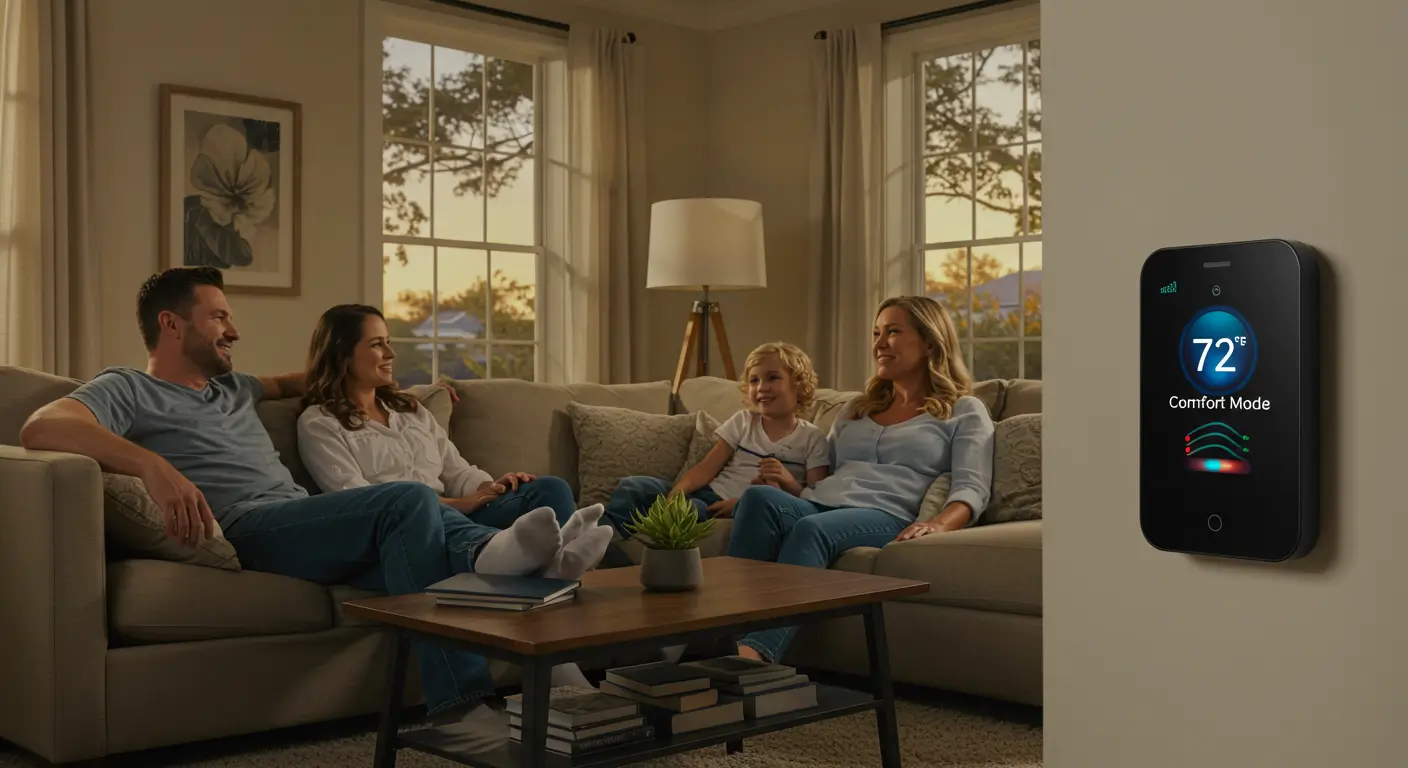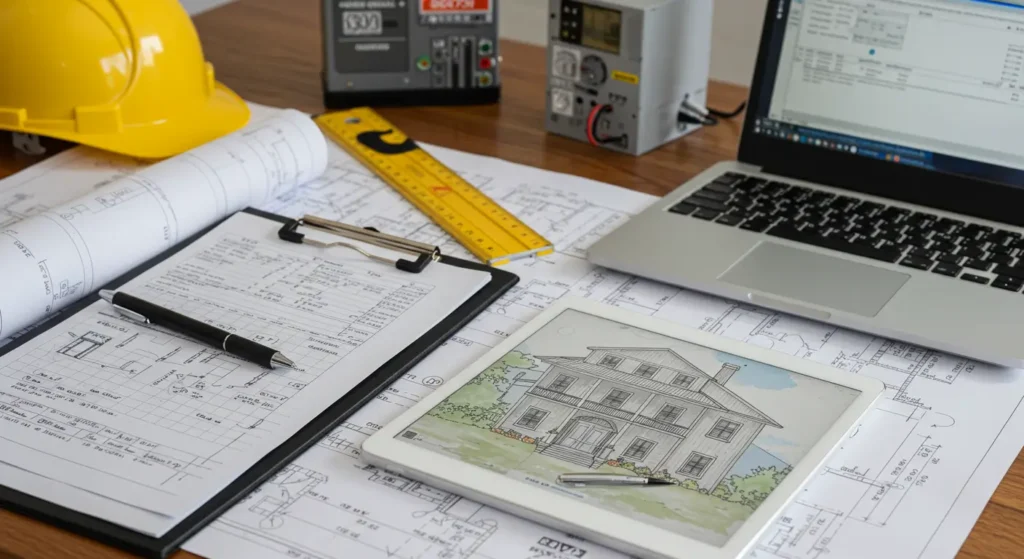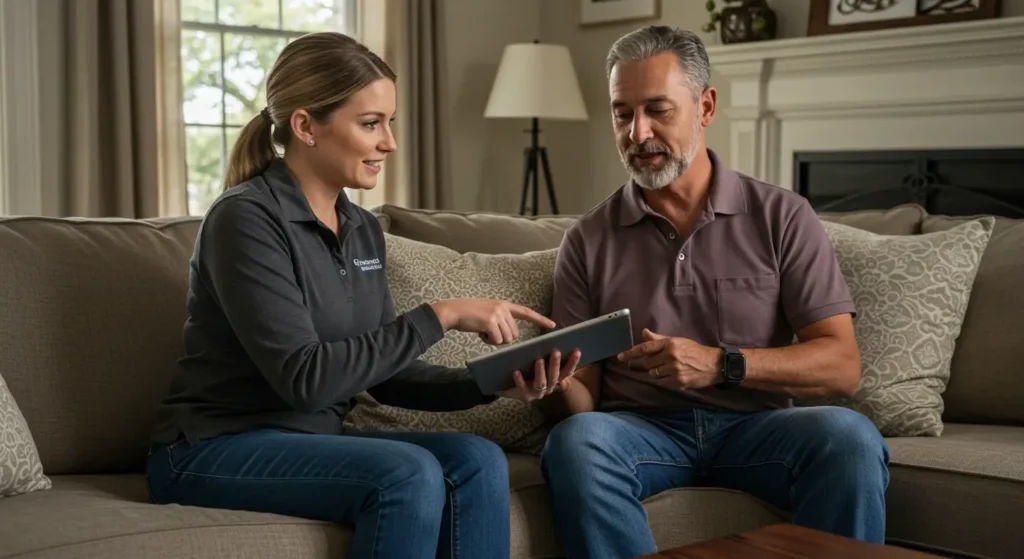Smart home HVAC technology transforms how New Orleans homeowners manage comfort and energy costs. Learn how connected systems, automation, and intelligent controls can save money while battling our challenging climate.
Table of Contents
Your grandparents cooled their New Orleans home by opening windows and praying for a breeze. Your parents got window units and fought over the thermostat. Today, smart home HVAC technology is revolutionizing how we battle the heat and humidity, and it’s about time.
We’re not just talking about controlling your AC with your phone (though that’s pretty nice when you’re lying in bed and don’t want to get up). Smart home HVAC represents a complete shift in how heating and cooling systems operate – from reactive machines that wait for your input to intelligent systems that anticipate your needs, adapt to weather changes, and optimize energy use automatically.
After installing and servicing HVAC systems across New Orleans for over a decade, we’ve watched this technology evolve from expensive novelty to essential upgrade. What we’ve learned at Hagerman Services is that smart home HVAC isn’t just about convenience – it’s about finally having technology sophisticated enough to handle our unique climate challenges while actually saving money.
The Smart Home HVAC Revolution in New Orleans
Let’s be clear about what we mean by smart home HVAC. This isn’t just a programmable thermostat with an app. We’re talking about an ecosystem of connected devices that work together to maintain comfort while minimizing energy waste.
Smart home HVAC includes connected thermostats that learn and adapt, zoning systems that cool only occupied areas, air quality monitors that trigger ventilation or filtration, humidity sensors that maintain optimal moisture levels, and integration with other home systems for coordinated efficiency. These components communicate with each other, sharing data and making decisions that no single device could make alone.
Why this matters in New Orleans specifically:
Our climate isn’t just hot – it’s complex. We deal with 70%+ humidity regularly, temperature swings of 30 degrees in a single day, extended cooling seasons running March through November, hurricane season disruptions and power management, and air quality challenges from humidity and allergens.
Traditional HVAC systems struggle with these variables. They’re designed for simpler climates where temperature is the main concern. Smart home HVAC technology addresses our specific challenges by coordinating multiple systems to maintain comfort efficiently.
When your smart system detects rising humidity at 2 AM, it can run a dehumidification cycle without overcooling your bedroom. When a summer storm approaches, it can pre-cool your home before the power-hungry post-storm humidity spike. This isn’t future technology – it’s available today.
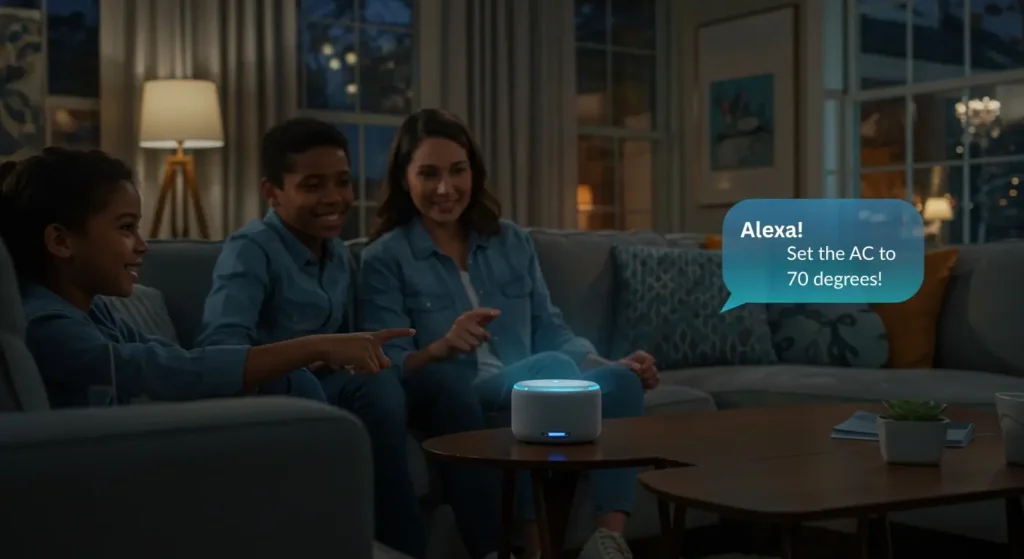
Building Your Smart HVAC Ecosystem
Creating a smart home HVAC system doesn’t mean replacing everything at once. Most homeowners start with one component and build from there. Understanding what’s available helps you make strategic upgrades that work together.
The foundation: Smart thermostats
The smart thermostat is typically your entry point. Models like Ecobee, Nest, and Honeywell don’t just control temperature – they’re the brain of your smart HVAC system. They learn your patterns, respond to weather forecasts, and coordinate with other devices.
Smart zoning systems
Why cool your entire house when you’re only using two rooms? Smart zoning divides your home into areas with independent control. Each zone gets its own temperature sensor and damper control, directing cooling exactly where needed.
In a typical New Orleans two-story home, smart zoning can reduce cooling costs by 30% by not overcooling downstairs to make upstairs comfortable. The system automatically balances zones based on occupancy, time of day, and sun exposure.
Air quality monitoring and control
Indoor air quality monitors track humidity, VOCs, CO2, and particulates. When integrated with your HVAC system, they can automatically trigger ventilation, adjust humidity, or activate air purification.
This is huge for New Orleans. Our air quality challenges go beyond temperature. Smart monitoring can detect when humidity creeps toward mold-friendly levels and intervene before problems develop.
Smart vents and registers
These replace traditional vents with automated versions that open and close based on room needs. Combined with temperature sensors, they create micro-zones without expensive ductwork modifications.
Perfect for that one room that’s always too hot or cold, smart vents redirect airflow dynamically. They’re especially useful in older New Orleans homes where ductwork modifications would be invasive or impossible.
Real Cost Savings with Smart Technology
Let’s talk money, because smart home HVAC technology isn’t cheap. But when you understand the real savings potential in our climate, the investment makes sense.
Baseline energy savings:
→ Smart thermostats alone: 15-23% reduction in cooling costs
→ Add smart zoning: Additional 20-30% savings
→ Include occupancy sensing: Another 10-15% reduction
→ Weather integration: 5-10% improvement
→ Total potential savings: 35-45% on cooling bills
For a typical New Orleans home spending $250 monthly on summer cooling, that’s $87-112 saved each month during peak season. Over our nine-month cooling season, you’re looking at $780-1,000 annual savings.
Beyond direct energy savings:
Maintenance costs drop when your system runs more efficiently. Components last longer when they’re not constantly cycling on and off. Smart diagnostics catch problems early, preventing expensive emergency repairs.
Equipment lifespan extends significantly. A traditional system might last 12-15 years in our climate. Smart-controlled systems, running more efficiently with less stress, often reach 15-20 years. That’s thousands saved in delayed replacement costs.
Utility rebates and incentives are increasingly available for smart home technology. Entergy and other providers occasionally offer rebates for smart thermostat installation. Some insurance companies provide discounts for homes with smart monitoring systems.
Integration with Your Existing Systems
One of the biggest concerns homeowners have is compatibility. Will smart technology work with your current HVAC equipment? The good news is that most systems installed in the last 20 years can be upgraded with smart controls.
Standard central air systems are the easiest to upgrade. If you have a traditional thermostat, you can almost certainly upgrade to smart controls. The main requirement is proper wiring (specifically a C-wire for power), which can be added if missing.
Heat pumps work excellently with smart controls. In fact, smart technology maximizes heat pump efficiency by optimizing the balance between heat pump and auxiliary heat operation – crucial for those occasional cold snaps.
Ductless mini-split systems increasingly come with smart capabilities built-in. Brands like Mitsubishi and LG offer ductless systems with Wi-Fi control and integration with major smart home platforms.
Window units and portable ACs can be made smart with smart outlets or specialized controllers. While not as sophisticated as central system control, you still get scheduling, remote control, and energy monitoring.
Bottom line: Unless your system is truly ancient or highly unusual, smart home HVAC technology can work with what you have.
Smart Home Platform Integration
The real magic happens when your HVAC system talks to other smart home devices. This coordination multiplies efficiency and convenience in ways that weren’t possible just a few years ago.
Voice assistants (Alexa, Google Home, Siri):
“Alexa, set the temperature to 72” is just the beginning. Modern integration allows complex commands like “Alexa, I’m going to bed” which can adjust temperature, turn off lights, and activate sleep-optimized humidity settings simultaneously.
During our humid mornings, you can say “Hey Google, morning routine” to adjust temperature, check weather, and pre-emptively run dehumidification if rain is forecast.
Smart sensors throughout your home:
Motion sensors tell your HVAC system which rooms are occupied. Door/window sensors prevent cooling when windows are open. Humidity sensors in bathrooms and basements trigger targeted dehumidification.
Water leak sensors near your HVAC equipment can shut down the system and alert you before major damage occurs – crucial for attic installations common in New Orleans.
Automated blinds and lighting:
Smart blinds that close during peak sun hours reduce cooling load by 20%. When integrated with your HVAC system, they coordinate to maintain comfort while minimizing energy use.
Smart lighting that adjusts based on natural light works with your HVAC to reduce heat generation from lights, further reducing cooling needs.
Whole-home platforms (SmartThings, Hubitat, Home Assistant):
These platforms coordinate everything. Your HVAC system becomes part of scenes like “Away Mode” that adjusts temperature, lighting, and security when you leave, or “Movie Night” that optimizes comfort while dimming lights.
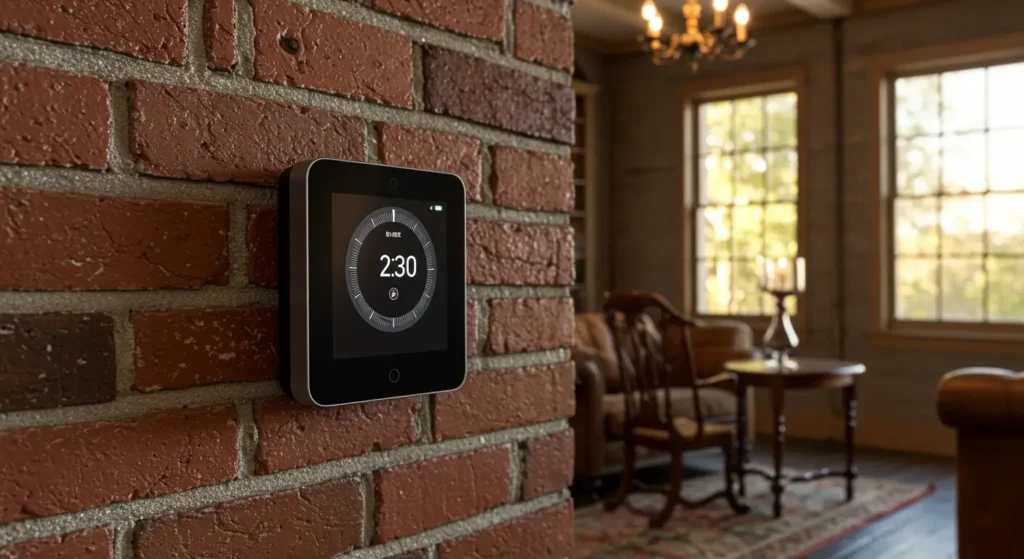
Future-Proofing Your Investment
Smart home technology evolves rapidly, but that doesn’t mean today’s investment will be obsolete tomorrow. Choosing the right technology and installation approach ensures your system stays relevant.
Industry standards are consolidating:
The new Matter/Thread protocol promises universal compatibility between brands. Major manufacturers are committing to these standards, meaning your Nest thermostat will work seamlessly with Ecobee sensors or Honeywell air quality monitors.
Energy grid integration is coming:
Utilities are developing demand response programs where your smart HVAC system can automatically adjust during peak demand periods in exchange for bill credits. Entergy is exploring these programs, and smart-ready systems will be first to benefit.
Time-of-use electricity rates reward shifting usage to off-peak hours. Smart HVAC systems can pre-cool during cheap rate periods, maintaining comfort while minimizing costs during expensive peak hours.
Climate adaptation features are advancing:
As weather patterns become more extreme, smart systems are adding predictive capabilities. Future updates will better anticipate and prepare for severe weather, optimizing for resilience as well as efficiency.
Integration with home battery systems and solar panels is improving. Your smart HVAC could prioritize solar power usage or switch to battery backup seamlessly during outages.
Making Smart Choices for Your Home
After years of installing smart home HVAC technology across New Orleans, we’ve learned that success comes from matching technology to your specific needs, not just buying the latest gadgets.
Start with your biggest pain points:
If high energy bills are killing you, prioritize smart thermostats and zoning. If comfort is the issue, focus on humidity control and room sensors. If convenience matters most, emphasize voice control and automation.
Consider your technical comfort level:
Some systems require more interaction than others. Nest learns automatically with minimal input. Ecobee offers more control but needs more setup. Choose complexity that matches your interest level.
Plan for phased implementation:
You don’t need everything at once. Start with a smart thermostat, add zone control next year, and integrate air quality monitoring when budget allows. Each addition builds on previous upgrades.
Professional guidance makes a difference:
Smart home HVAC involves electrical work, system compatibility, network configuration, and optimal placement of sensors. Professional installation ensures everything works together properly from day one.
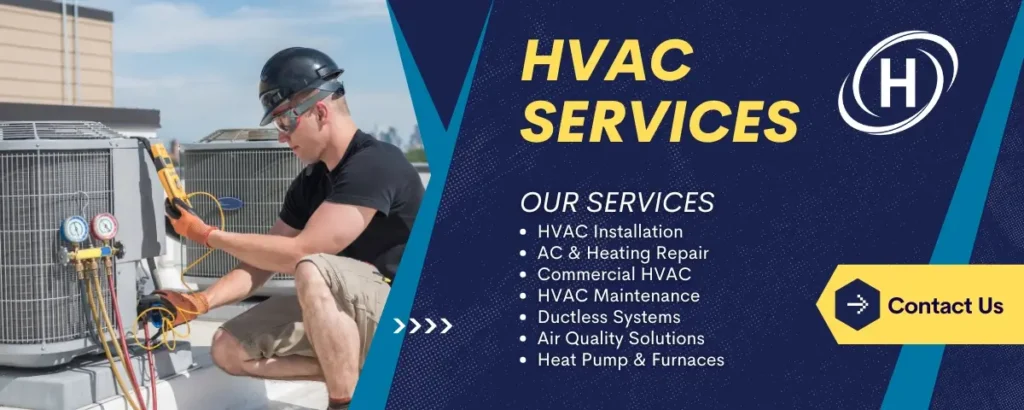
Your Path to Smarter Comfort
Smart home HVAC technology isn’t just about joining the connected home trend – it’s about finally having systems intelligent enough to handle New Orleans’ demanding climate while saving real money. With the right approach, you can transform your home’s comfort and efficiency.
The question isn’t whether smart home HVAC makes sense for New Orleans homes – it’s which technologies will benefit you most. Every home is different, every family has unique needs, and the right solution depends on your specific situation.
Contact Hagerman Services at (504) 314-1486 to explore smart home HVAC options for your home. We’ll assess your current system, recommend appropriate smart upgrades, and handle professional installation that maximizes benefits while ensuring reliability.
Because in a city where the weather never quite cooperates, it’s time your HVAC system got smart enough to fight back.
Frequently Asked Questions
Q: What is smart home HVAC technology?
A: Smart home HVAC technology includes Wi-Fi connected thermostats, zoning systems, air quality monitors, and automation that work together to optimize comfort and efficiency. These systems learn your habits, respond to weather changes, and can reduce New Orleans cooling costs by 15-23%.
Q: How much can smart HVAC technology save in New Orleans?
A: Smart HVAC systems typically save New Orleans homeowners $180-300 annually on cooling costs through optimized scheduling, humidity control, and automated adjustments. Combined with smart home integration, total savings can reach $400-500 yearly.
Q: What smart HVAC features work best for New Orleans climate?
A: Humidity sensing and control, weather-responsive adjustments, zone control for multi-story homes, and air quality monitoring are essential smart features for New Orleans. These technologies address our 70%+ humidity and 9-month cooling season challenges.
Q: Can older New Orleans homes use smart HVAC technology?
A: Yes, most homes built after 1960 can use smart HVAC technology with minor modifications. Historic homes may need C-wire installation or wireless adapters. Ductless smart systems work perfectly in older homes without existing ductwork.
Q: Which smart home systems work with HVAC in New Orleans?
A: Popular integrations include Alexa and Google Home for voice control, smart sensors for humidity monitoring, automated blinds for heat reduction, and whole-home platforms like SmartThings or Hubitat that coordinate multiple systems for maximum efficiency.
Q: Is smart HVAC technology worth it in New Orleans?
A: Absolutely. With our extended cooling season and high humidity, smart HVAC technology typically pays for itself within 12-18 months through energy savings. Added comfort, convenience, and home value make it one of the best home improvements for our climate.
